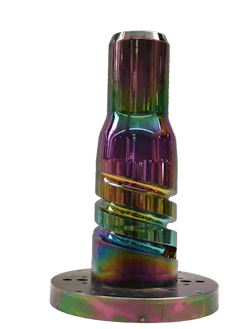BBM uses digital twins to design blow molding die heads
By Bruce Geiselman
Artificial intelligence and digital twin technology have helped blow molding machinery manufacturer BBM Maschinenbau und Vertriebs GmbH significantly reduce engineering time and costs while designing more efficient die heads. With the approach, the company is helping its customers make more-sustainable products.
“One of the main benefits is that we are able to test a high amount of different designs without an engineer to prepare all the models or think about which solution you already tried, or things like that,” said Felix Schulte, BBM’s chief technology officer. “It's beneficial because the main engineering is done by the software, which does all the trial-and-error testing.”
The Germany-based manufacturer, which provides solutions tailored for specific customers’ needs, has used the strategies since 2021 to avoid the need for extensive prototyping.
BBM’s designs allow blow molding machine customers to increase their use of post-consumer resin (PCR) in blow molded products.
“We are able to design the die head for the PCR that the customer would like to use in his process,” Schulte said. “For example, we developed two years ago a die head for one of our customers where it is possible to have 80 percent or more PCR and also have inner and outer layers covering that material.”
Digital twin technology, employing AI-driven optimization and advanced computational fluid dynamics (CFD) simulations, significantly improved BBM’s design and performance capabilities of its die heads, including helical distributors for multiple-layer molding.
Before digital twin technology, die head design was a trial-and-error process involving the building of prototype die heads and extensive field testing. The new process involves creating a 3D model of the head, simulating it in software, and allowing engineers to interpret the results. The process is now more efficient and customized.
“We can simulate thousands of different designs in this software so we get the survival of the fittest — the best will be taken out of these results,” Schulte said. “It’s the same thing an engineer would do, but with a lot of different versions and a lot faster.”
Without digital twin technology, the maximum PCR content is typically around 60 percent to 70 percent, he said.
BBM’s software, developed with partner Ianus Simulation, also of Germany, automates the design process, improving accuracy and efficiency.
To run the simulations, BBM engineers input what Schulte called “boundary conditions,” such as what material will be used, throughput speed and process temperature.
“With all those boundaries, we can start up the software, and the software will start to design the spiral [helical] distributor for the application,” Schulte said. “The process depends on how many boundaries we put into the simulation. It can take several days, up to a week or two [to run].”
The simulations are generally quite accurate, but they need to be analyzed by an experienced engineer to determine if all the data are valid, he said.
BBM is exploring future applications for digital twin technology in improving energy efficiency and overall blow molding machine performance.
Schulte said he is unaware of other blow molding machine die head manufacturers using digital twin technology in designing die heads, but he said Ianus is developing technology for other plastics processes, including extrusion.
On its website, Ianus touts the availability of simulation tools for use in extrusion, injection molding and hot-runner design.
Contact:
BBM America, Mason City, Iowa, 641-903-0966, https://bbm-germany.de/?lang=en
About the Author
Bruce Geiselman
Senior Staff Reporter Bruce Geiselman covers extrusion, blow molding, additive manufacturing, automation and end markets including automotive and packaging. He also writes features, including In Other Words and Problem Solved, for Plastics Machinery & Manufacturing, Plastics Recycling and The Journal of Blow Molding. He has extensive experience in daily and magazine journalism.
